Improving Oncology, Haematology, and Palliative Patients Flow in NCCCR
VerifiedAdded on 2023/01/06
|17
|4618
|58
AI Summary
This document discusses the current understanding of the system/process in the Oncology and Haematology department, the rationale and drivers for improvement, stakeholder analysis and engagement plan, risk analysis, expected benefits, and methods to be used for improving oncology, haematology, and palliative patients flow in the National Centre for Cancer Care and Research (NCCCR).
Contribute Materials
Your contribution can guide someone’s learning journey. Share your
documents today.
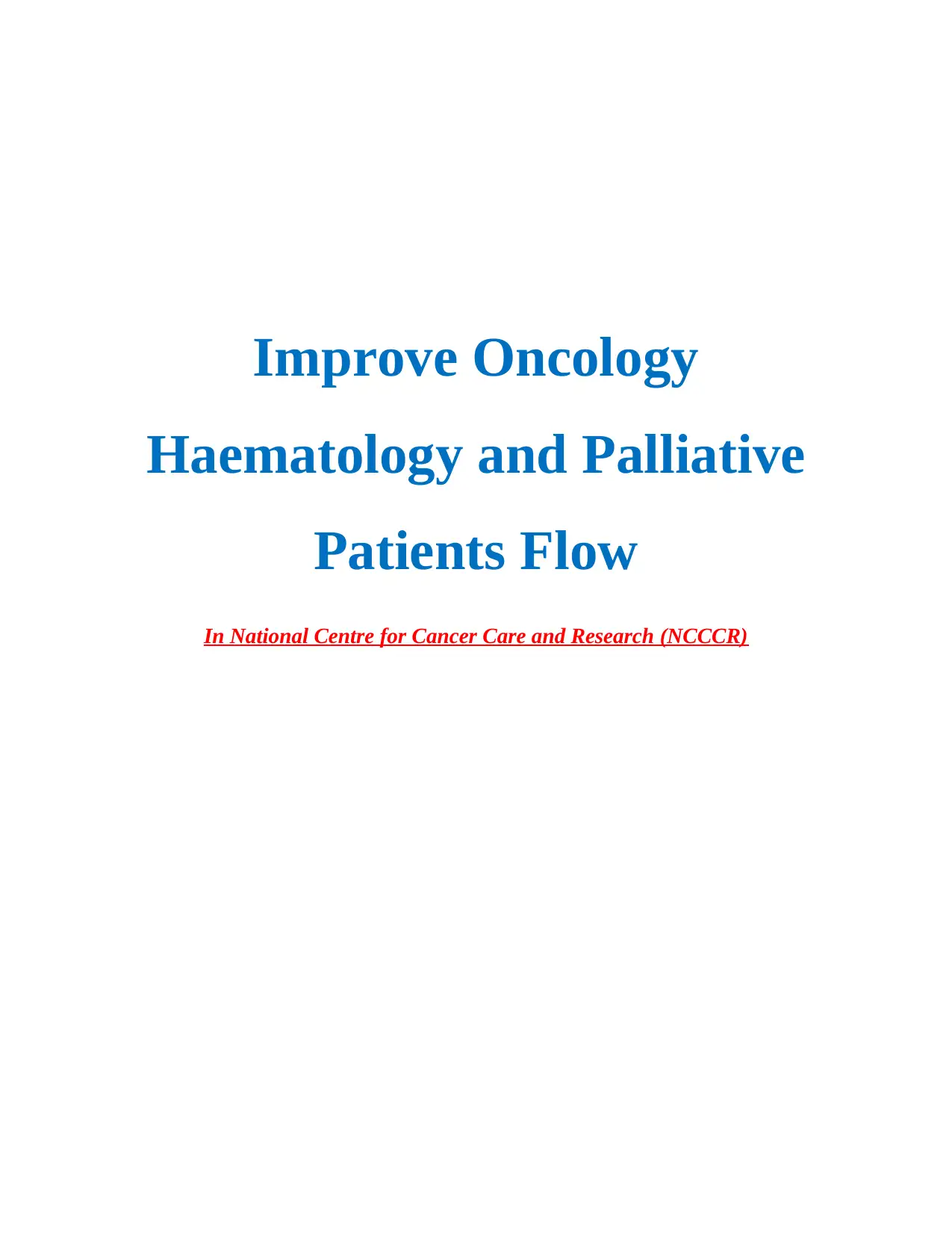
Improve Oncology
Haematology and Palliative
Patients Flow
In National Centre for Cancer Care and Research (NCCCR)
Haematology and Palliative
Patients Flow
In National Centre for Cancer Care and Research (NCCCR)
Secure Best Marks with AI Grader
Need help grading? Try our AI Grader for instant feedback on your assignments.
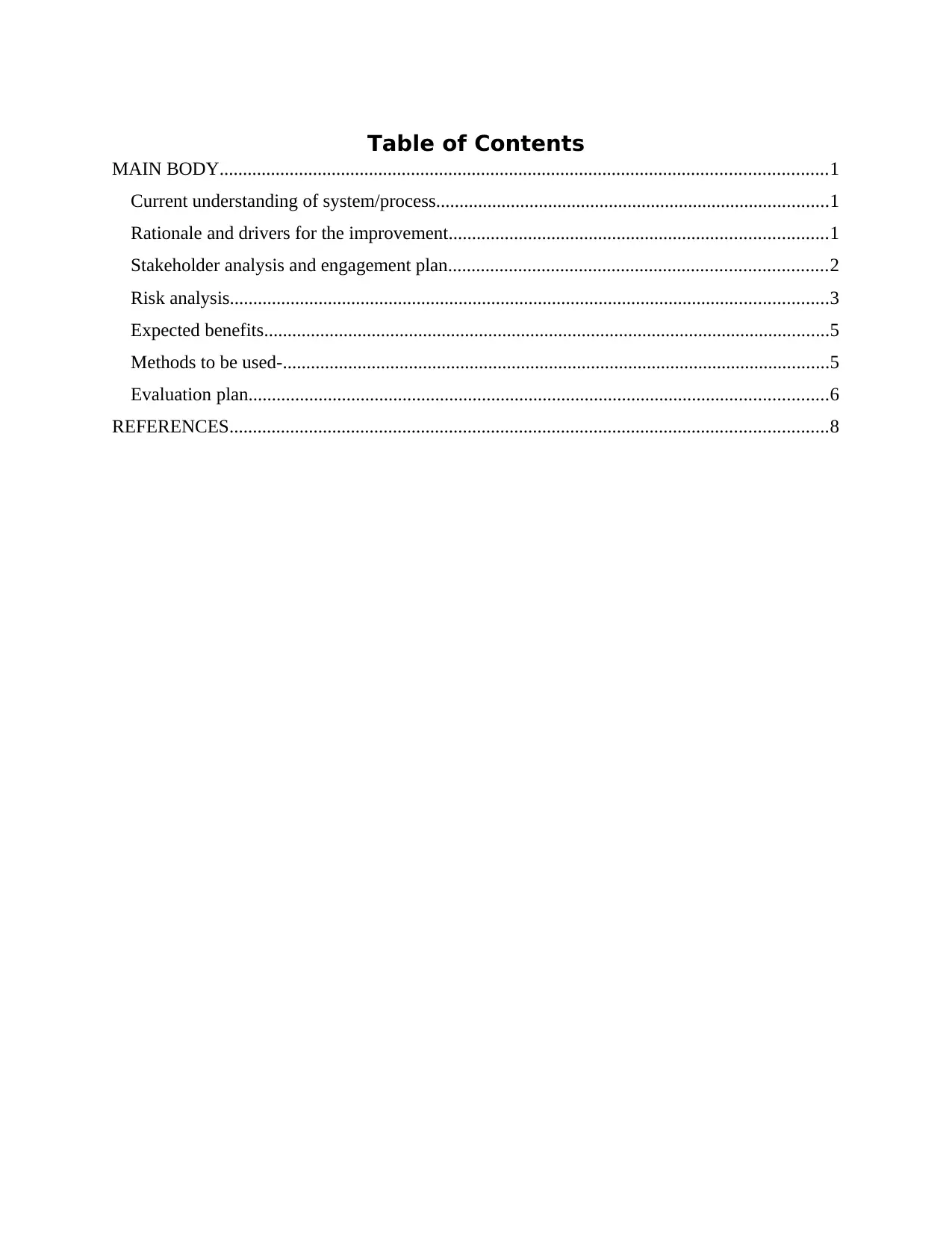
Table of Contents
MAIN BODY..................................................................................................................................1
Current understanding of system/process....................................................................................1
Rationale and drivers for the improvement.................................................................................1
Stakeholder analysis and engagement plan.................................................................................2
Risk analysis................................................................................................................................3
Expected benefits.........................................................................................................................5
Methods to be used-.....................................................................................................................5
Evaluation plan............................................................................................................................6
REFERENCES................................................................................................................................8
MAIN BODY..................................................................................................................................1
Current understanding of system/process....................................................................................1
Rationale and drivers for the improvement.................................................................................1
Stakeholder analysis and engagement plan.................................................................................2
Risk analysis................................................................................................................................3
Expected benefits.........................................................................................................................5
Methods to be used-.....................................................................................................................5
Evaluation plan............................................................................................................................6
REFERENCES................................................................................................................................8
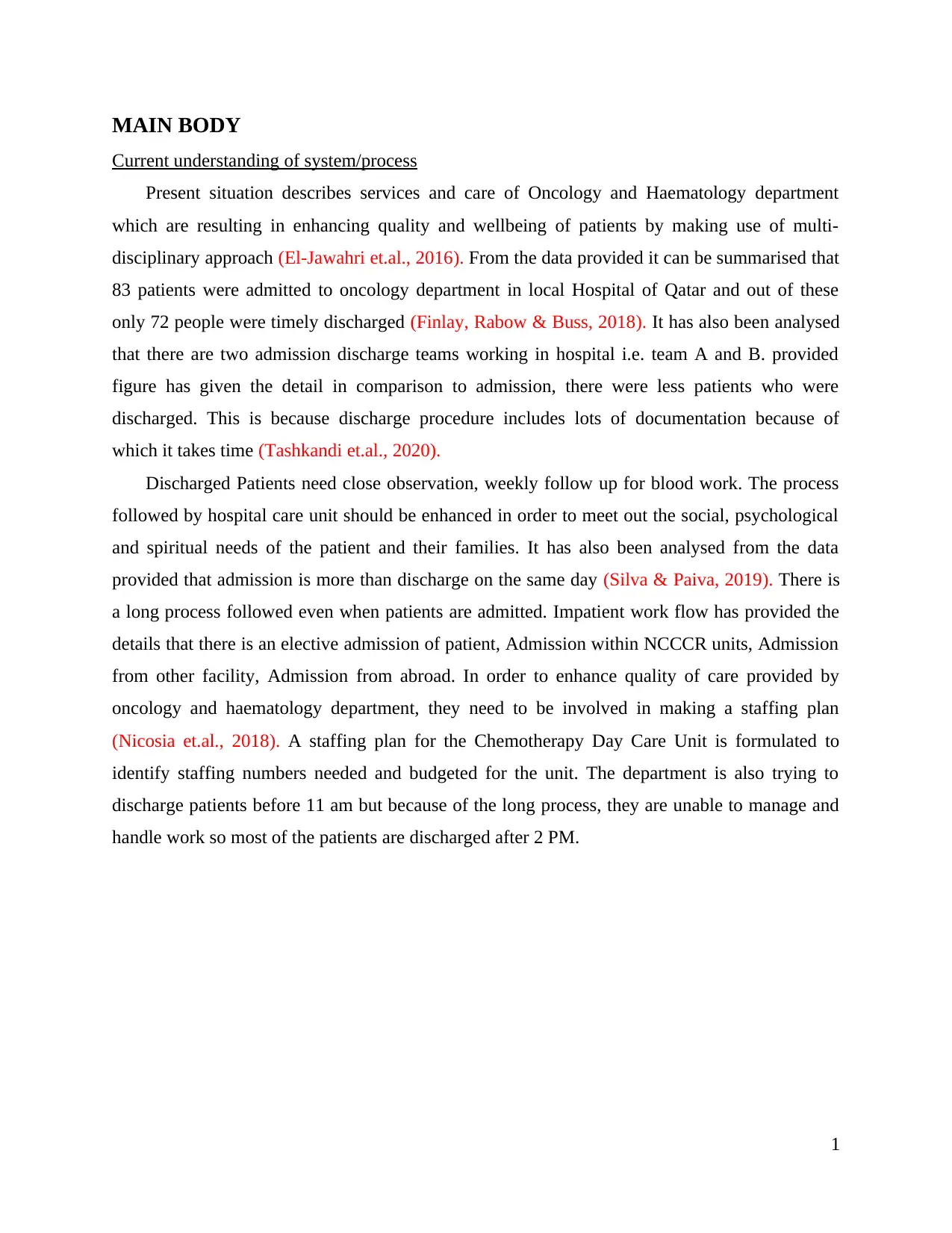
MAIN BODY
Current understanding of system/process
Present situation describes services and care of Oncology and Haematology department
which are resulting in enhancing quality and wellbeing of patients by making use of multi-
disciplinary approach (El-Jawahri et.al., 2016). From the data provided it can be summarised that
83 patients were admitted to oncology department in local Hospital of Qatar and out of these
only 72 people were timely discharged (Finlay, Rabow & Buss, 2018). It has also been analysed
that there are two admission discharge teams working in hospital i.e. team A and B. provided
figure has given the detail in comparison to admission, there were less patients who were
discharged. This is because discharge procedure includes lots of documentation because of
which it takes time (Tashkandi et.al., 2020).
Discharged Patients need close observation, weekly follow up for blood work. The process
followed by hospital care unit should be enhanced in order to meet out the social, psychological
and spiritual needs of the patient and their families. It has also been analysed from the data
provided that admission is more than discharge on the same day (Silva & Paiva, 2019). There is
a long process followed even when patients are admitted. Impatient work flow has provided the
details that there is an elective admission of patient, Admission within NCCCR units, Admission
from other facility, Admission from abroad. In order to enhance quality of care provided by
oncology and haematology department, they need to be involved in making a staffing plan
(Nicosia et.al., 2018). A staffing plan for the Chemotherapy Day Care Unit is formulated to
identify staffing numbers needed and budgeted for the unit. The department is also trying to
discharge patients before 11 am but because of the long process, they are unable to manage and
handle work so most of the patients are discharged after 2 PM.
1
Current understanding of system/process
Present situation describes services and care of Oncology and Haematology department
which are resulting in enhancing quality and wellbeing of patients by making use of multi-
disciplinary approach (El-Jawahri et.al., 2016). From the data provided it can be summarised that
83 patients were admitted to oncology department in local Hospital of Qatar and out of these
only 72 people were timely discharged (Finlay, Rabow & Buss, 2018). It has also been analysed
that there are two admission discharge teams working in hospital i.e. team A and B. provided
figure has given the detail in comparison to admission, there were less patients who were
discharged. This is because discharge procedure includes lots of documentation because of
which it takes time (Tashkandi et.al., 2020).
Discharged Patients need close observation, weekly follow up for blood work. The process
followed by hospital care unit should be enhanced in order to meet out the social, psychological
and spiritual needs of the patient and their families. It has also been analysed from the data
provided that admission is more than discharge on the same day (Silva & Paiva, 2019). There is
a long process followed even when patients are admitted. Impatient work flow has provided the
details that there is an elective admission of patient, Admission within NCCCR units, Admission
from other facility, Admission from abroad. In order to enhance quality of care provided by
oncology and haematology department, they need to be involved in making a staffing plan
(Nicosia et.al., 2018). A staffing plan for the Chemotherapy Day Care Unit is formulated to
identify staffing numbers needed and budgeted for the unit. The department is also trying to
discharge patients before 11 am but because of the long process, they are unable to manage and
handle work so most of the patients are discharged after 2 PM.
1
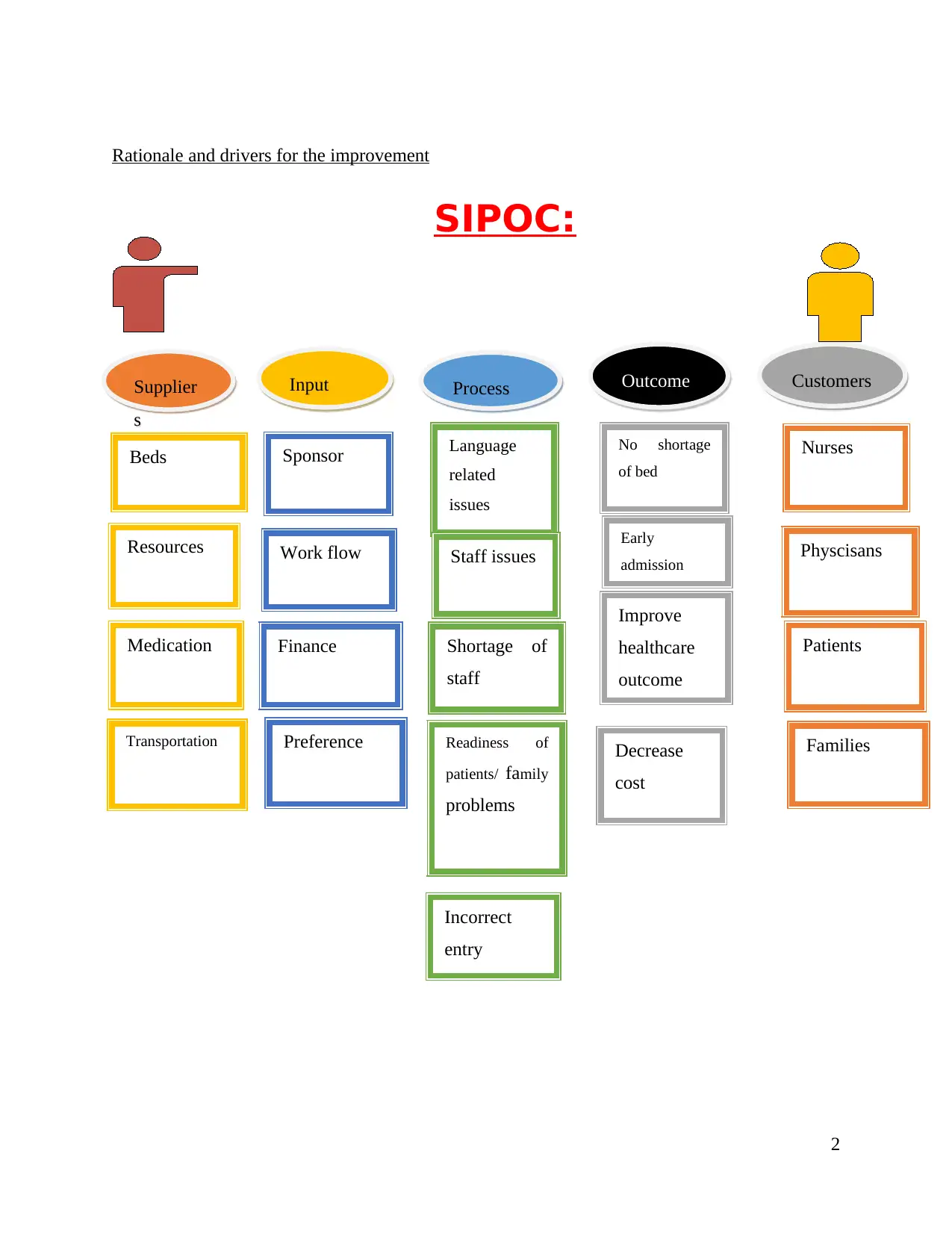
Rationale and drivers for the improvement
2
Supplier
s
Input Process Outcome Customers
Beds
Resources
Medication
Transportation
Sponsor
Work flow
Finance
Preference
Language
related
issues
Staff issues
Shortage of
staff
Readiness of
patients/ family
problems
Incorrect
entry
No shortage
of bed
Early
admission
Improve
healthcare
outcome
Nurses
Physcisans
Patients
Families
SIPOC:
Decrease
cost
2
Supplier
s
Input Process Outcome Customers
Beds
Resources
Medication
Transportation
Sponsor
Work flow
Finance
Preference
Language
related
issues
Staff issues
Shortage of
staff
Readiness of
patients/ family
problems
Incorrect
entry
No shortage
of bed
Early
admission
Improve
healthcare
outcome
Nurses
Physcisans
Patients
Families
SIPOC:
Decrease
cost
Secure Best Marks with AI Grader
Need help grading? Try our AI Grader for instant feedback on your assignments.
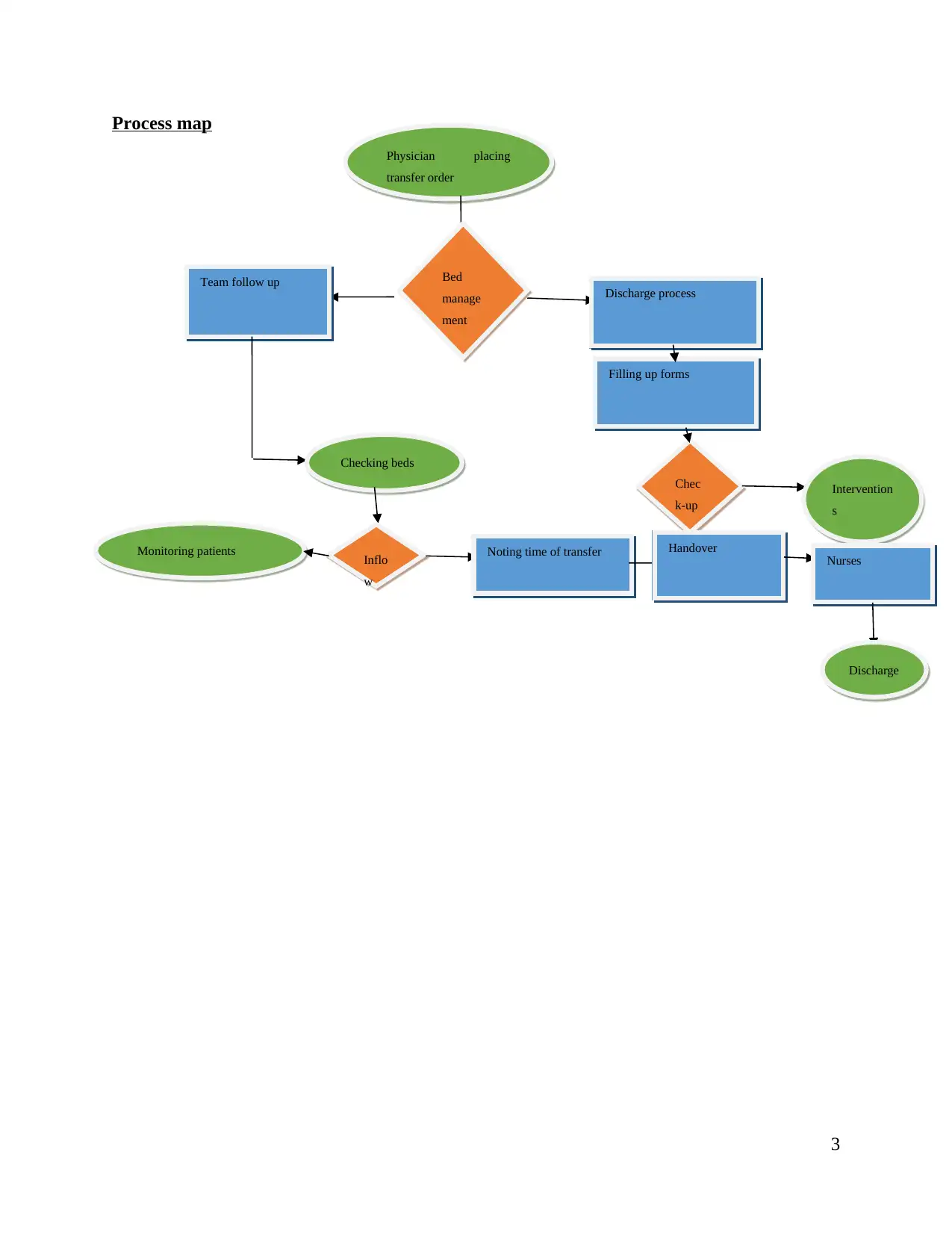
Process map
3
Physician placing
transfer order
Bed
manage
ment
Discharge process
Team follow up
Checking beds
Filling up forms
Chec
k-up
Intervention
s
Monitoring patients Inflo
w
Noting time of transfer Handover
Nurses
Discharge
3
Physician placing
transfer order
Bed
manage
ment
Discharge process
Team follow up
Checking beds
Filling up forms
Chec
k-up
Intervention
s
Monitoring patients Inflo
w
Noting time of transfer Handover
Nurses
Discharge
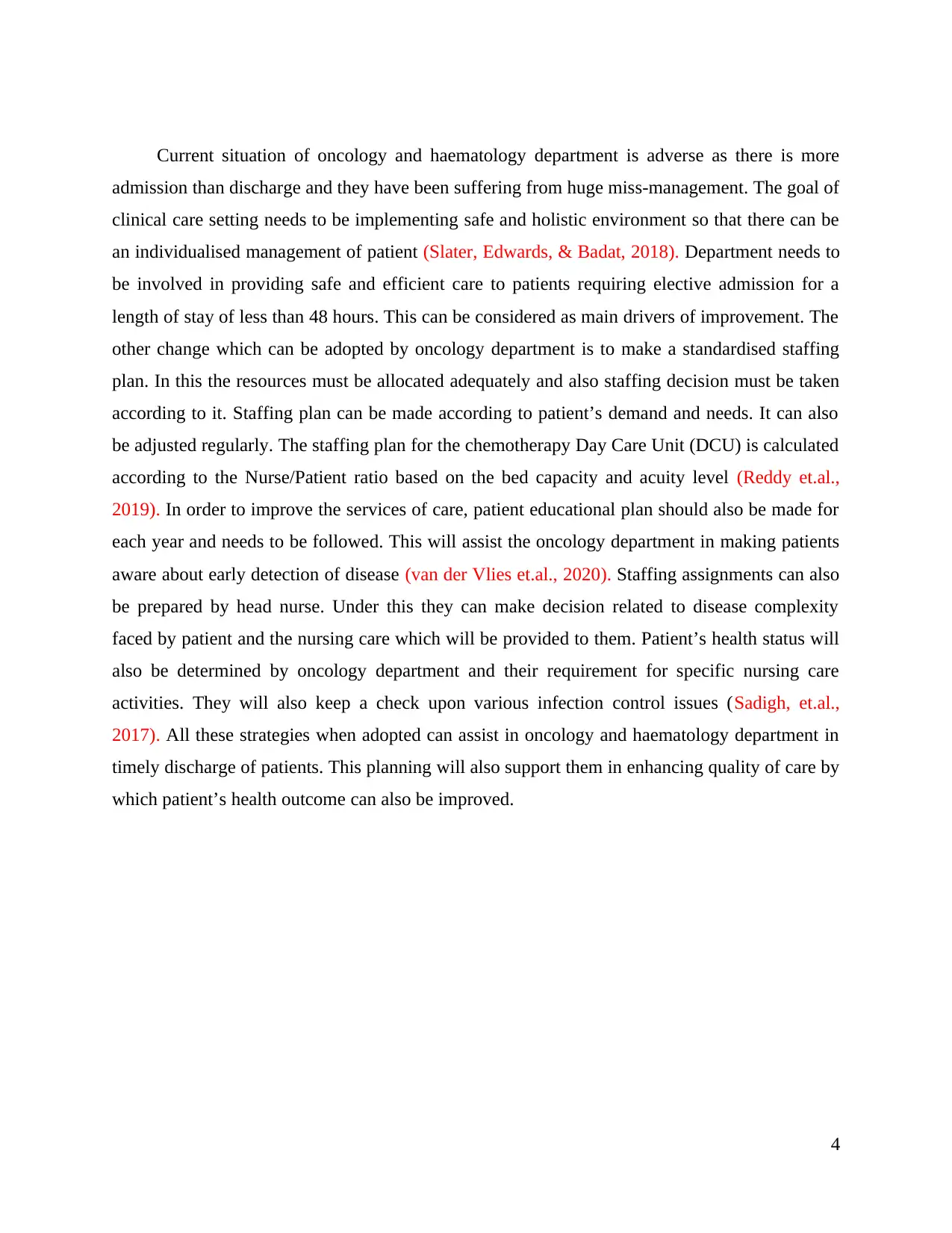
Current situation of oncology and haematology department is adverse as there is more
admission than discharge and they have been suffering from huge miss-management. The goal of
clinical care setting needs to be implementing safe and holistic environment so that there can be
an individualised management of patient (Slater, Edwards, & Badat, 2018). Department needs to
be involved in providing safe and efficient care to patients requiring elective admission for a
length of stay of less than 48 hours. This can be considered as main drivers of improvement. The
other change which can be adopted by oncology department is to make a standardised staffing
plan. In this the resources must be allocated adequately and also staffing decision must be taken
according to it. Staffing plan can be made according to patient’s demand and needs. It can also
be adjusted regularly. The staffing plan for the chemotherapy Day Care Unit (DCU) is calculated
according to the Nurse/Patient ratio based on the bed capacity and acuity level (Reddy et.al.,
2019). In order to improve the services of care, patient educational plan should also be made for
each year and needs to be followed. This will assist the oncology department in making patients
aware about early detection of disease (van der Vlies et.al., 2020). Staffing assignments can also
be prepared by head nurse. Under this they can make decision related to disease complexity
faced by patient and the nursing care which will be provided to them. Patient’s health status will
also be determined by oncology department and their requirement for specific nursing care
activities. They will also keep a check upon various infection control issues (Sadigh, et.al.,
2017). All these strategies when adopted can assist in oncology and haematology department in
timely discharge of patients. This planning will also support them in enhancing quality of care by
which patient’s health outcome can also be improved.
4
admission than discharge and they have been suffering from huge miss-management. The goal of
clinical care setting needs to be implementing safe and holistic environment so that there can be
an individualised management of patient (Slater, Edwards, & Badat, 2018). Department needs to
be involved in providing safe and efficient care to patients requiring elective admission for a
length of stay of less than 48 hours. This can be considered as main drivers of improvement. The
other change which can be adopted by oncology department is to make a standardised staffing
plan. In this the resources must be allocated adequately and also staffing decision must be taken
according to it. Staffing plan can be made according to patient’s demand and needs. It can also
be adjusted regularly. The staffing plan for the chemotherapy Day Care Unit (DCU) is calculated
according to the Nurse/Patient ratio based on the bed capacity and acuity level (Reddy et.al.,
2019). In order to improve the services of care, patient educational plan should also be made for
each year and needs to be followed. This will assist the oncology department in making patients
aware about early detection of disease (van der Vlies et.al., 2020). Staffing assignments can also
be prepared by head nurse. Under this they can make decision related to disease complexity
faced by patient and the nursing care which will be provided to them. Patient’s health status will
also be determined by oncology department and their requirement for specific nursing care
activities. They will also keep a check upon various infection control issues (Sadigh, et.al.,
2017). All these strategies when adopted can assist in oncology and haematology department in
timely discharge of patients. This planning will also support them in enhancing quality of care by
which patient’s health outcome can also be improved.
4
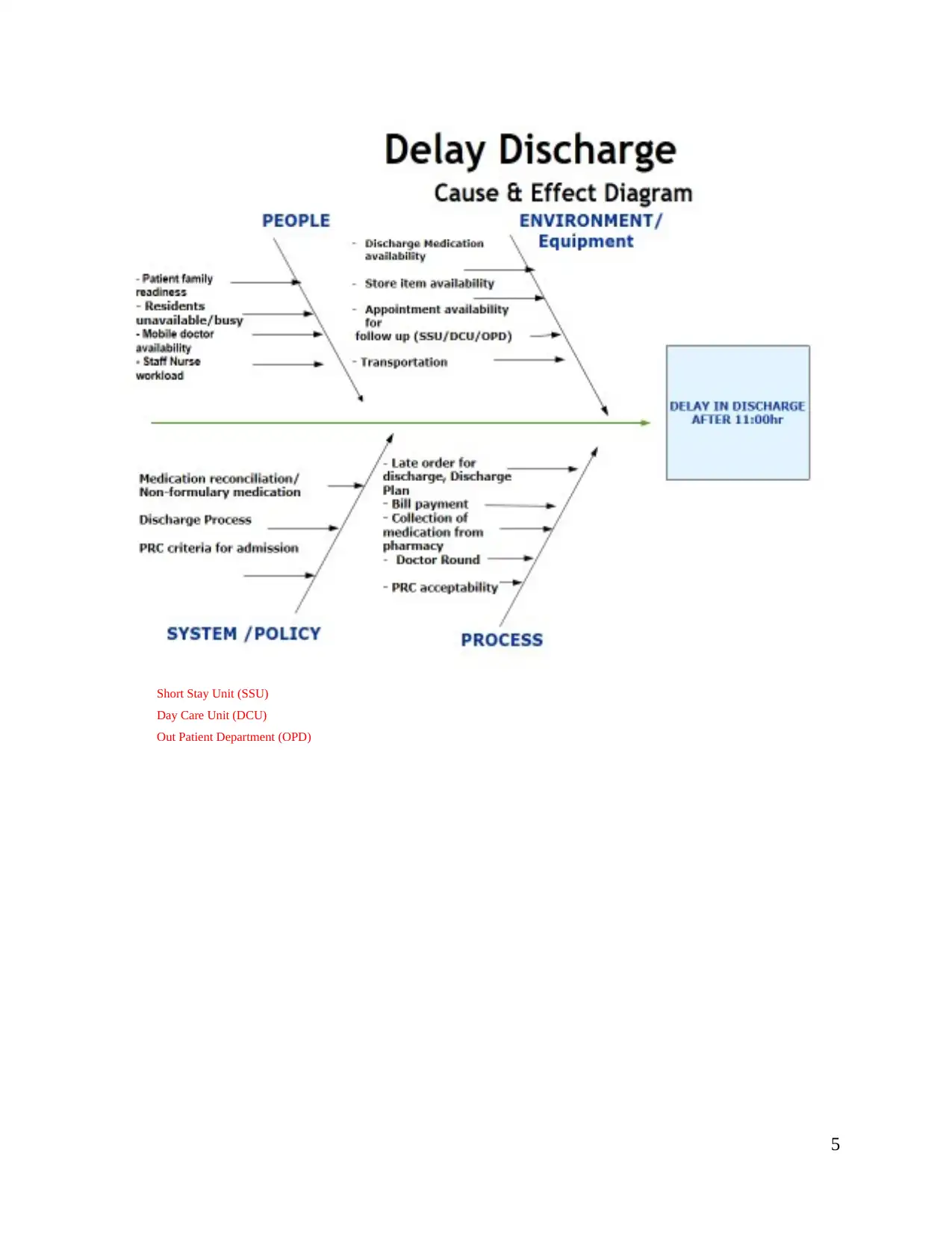
Short Stay Unit (SSU)
Day Care Unit (DCU)
Out Patient Department (OPD)
5
Day Care Unit (DCU)
Out Patient Department (OPD)
5
Paraphrase This Document
Need a fresh take? Get an instant paraphrase of this document with our AI Paraphraser
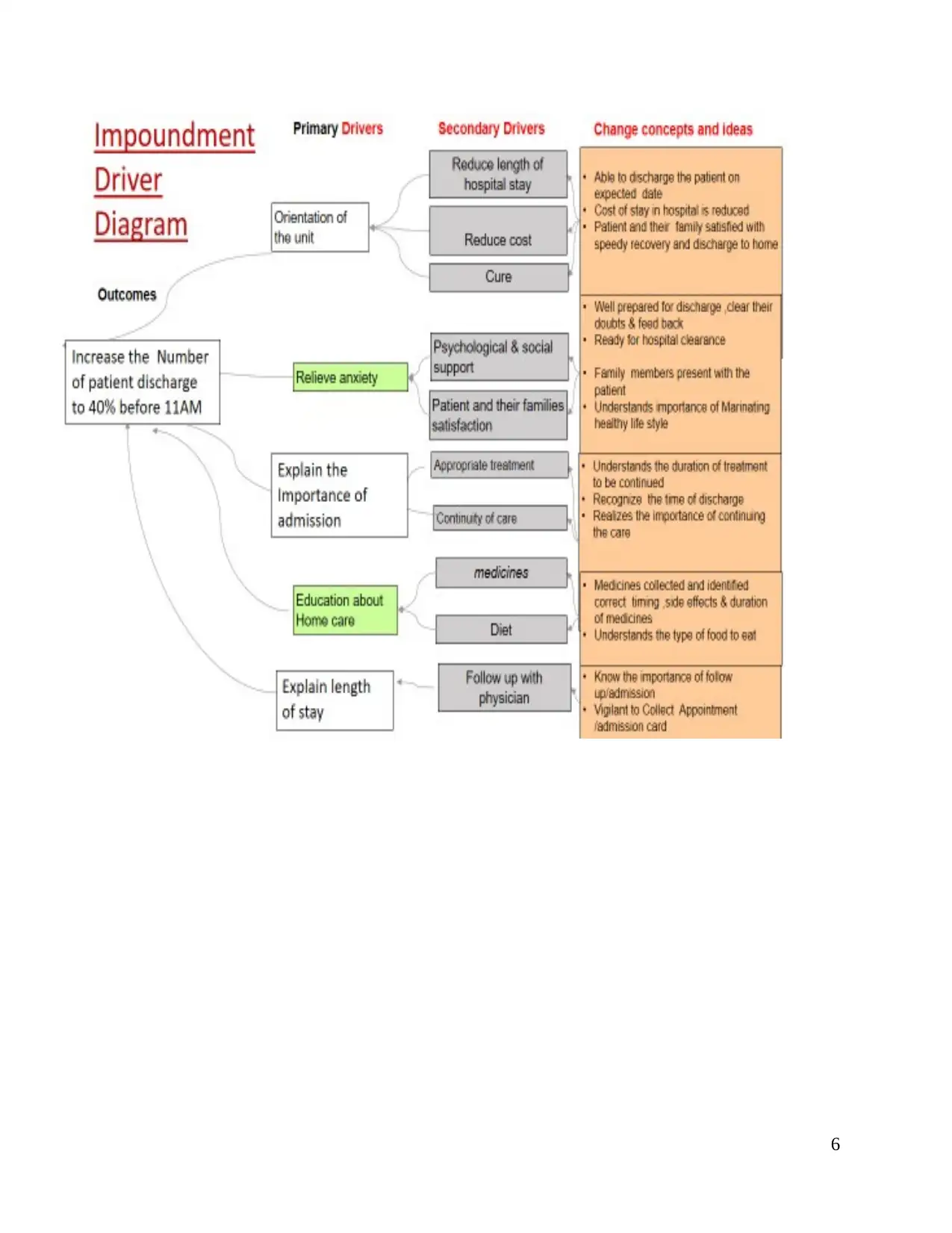
6
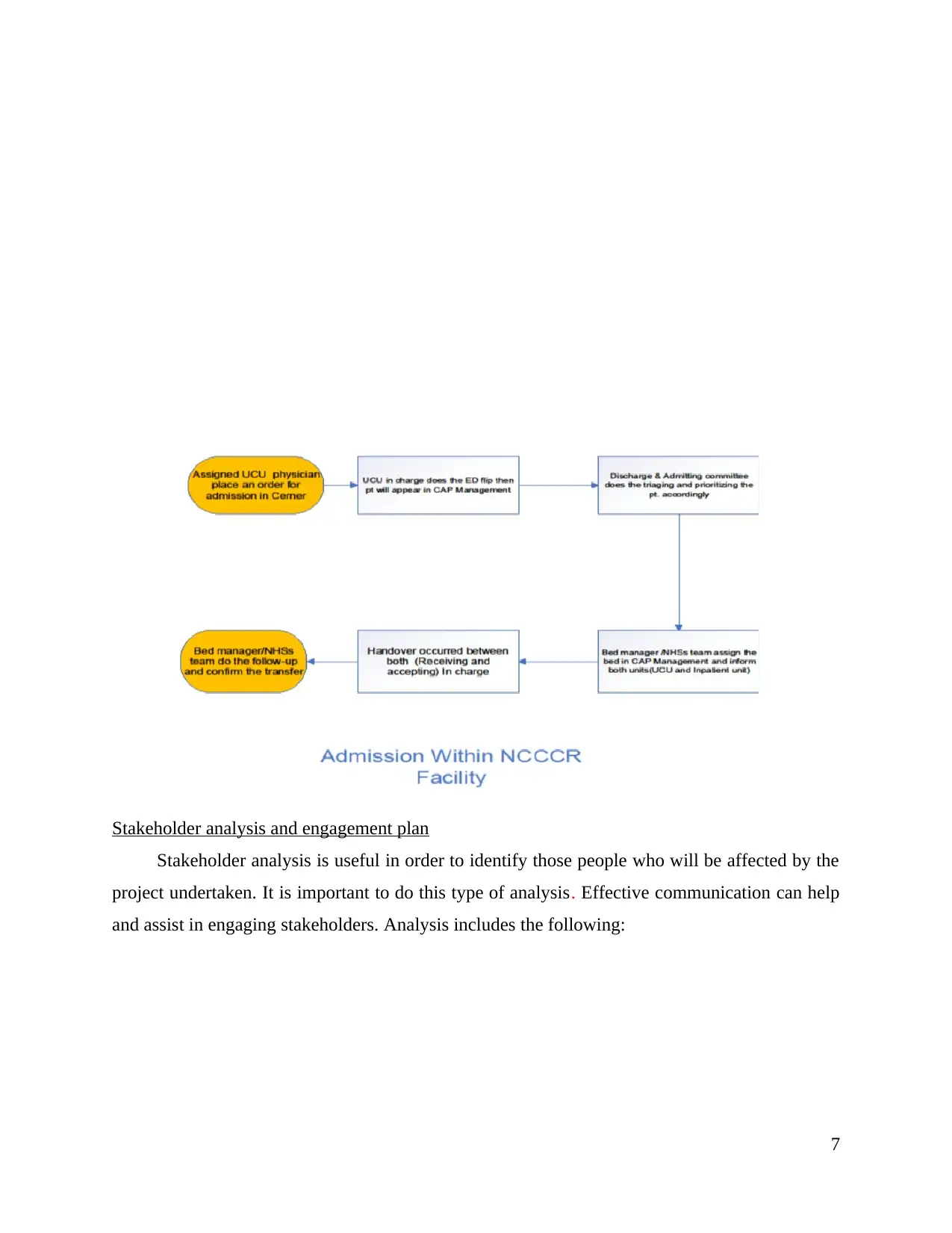
Stakeholder analysis and engagement plan
Stakeholder analysis is useful in order to identify those people who will be affected by the
project undertaken. It is important to do this type of analysis. Effective communication can help
and assist in engaging stakeholders. Analysis includes the following:
7
Stakeholder analysis is useful in order to identify those people who will be affected by the
project undertaken. It is important to do this type of analysis. Effective communication can help
and assist in engaging stakeholders. Analysis includes the following:
7
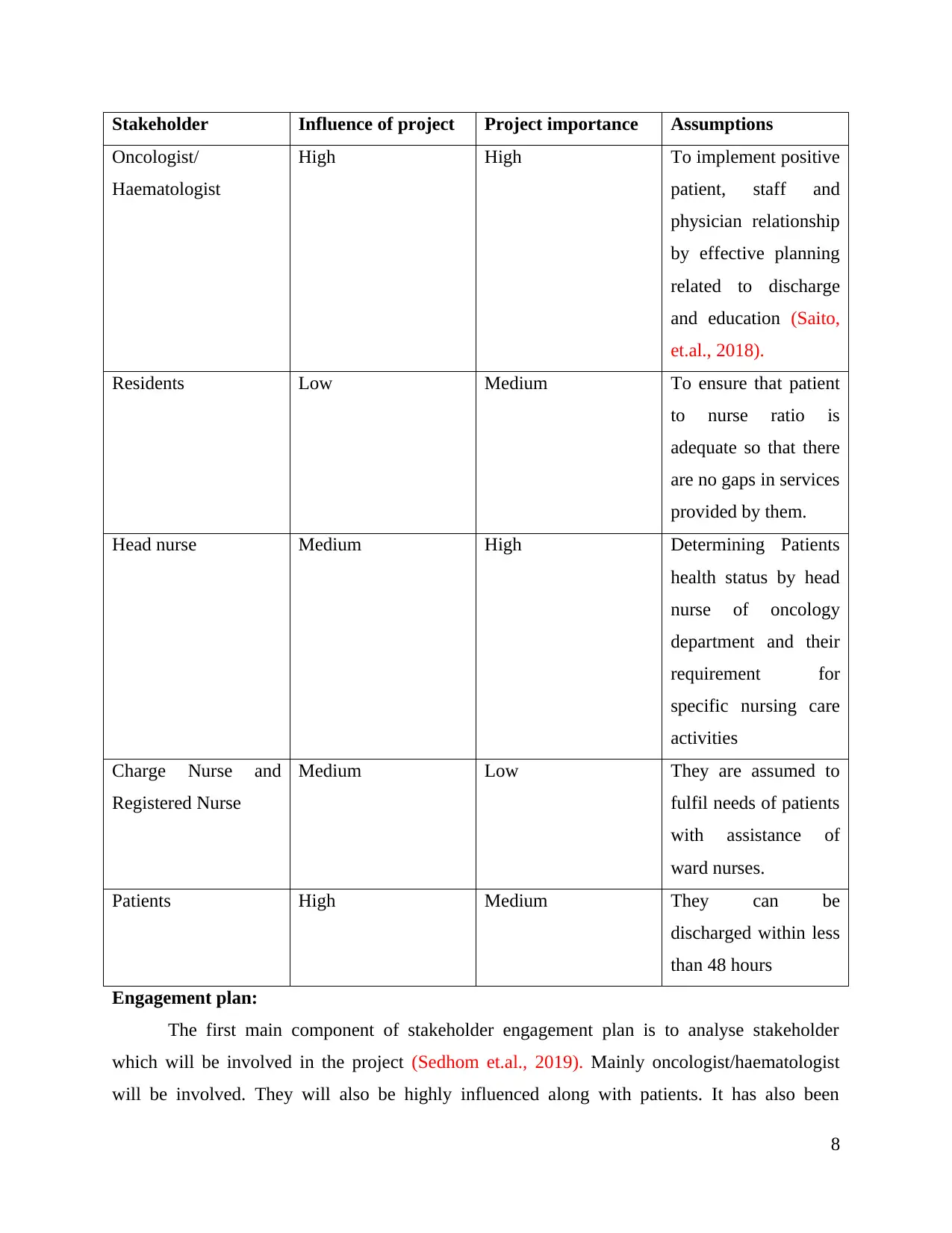
Stakeholder Influence of project Project importance Assumptions
Oncologist/
Haematologist
High High To implement positive
patient, staff and
physician relationship
by effective planning
related to discharge
and education (Saito,
et.al., 2018).
Residents Low Medium To ensure that patient
to nurse ratio is
adequate so that there
are no gaps in services
provided by them.
Head nurse Medium High Determining Patients
health status by head
nurse of oncology
department and their
requirement for
specific nursing care
activities
Charge Nurse and
Registered Nurse
Medium Low They are assumed to
fulfil needs of patients
with assistance of
ward nurses.
Patients High Medium They can be
discharged within less
than 48 hours
Engagement plan:
The first main component of stakeholder engagement plan is to analyse stakeholder
which will be involved in the project (Sedhom et.al., 2019). Mainly oncologist/haematologist
will be involved. They will also be highly influenced along with patients. It has also been
8
Oncologist/
Haematologist
High High To implement positive
patient, staff and
physician relationship
by effective planning
related to discharge
and education (Saito,
et.al., 2018).
Residents Low Medium To ensure that patient
to nurse ratio is
adequate so that there
are no gaps in services
provided by them.
Head nurse Medium High Determining Patients
health status by head
nurse of oncology
department and their
requirement for
specific nursing care
activities
Charge Nurse and
Registered Nurse
Medium Low They are assumed to
fulfil needs of patients
with assistance of
ward nurses.
Patients High Medium They can be
discharged within less
than 48 hours
Engagement plan:
The first main component of stakeholder engagement plan is to analyse stakeholder
which will be involved in the project (Sedhom et.al., 2019). Mainly oncologist/haematologist
will be involved. They will also be highly influenced along with patients. It has also been
8
Secure Best Marks with AI Grader
Need help grading? Try our AI Grader for instant feedback on your assignments.
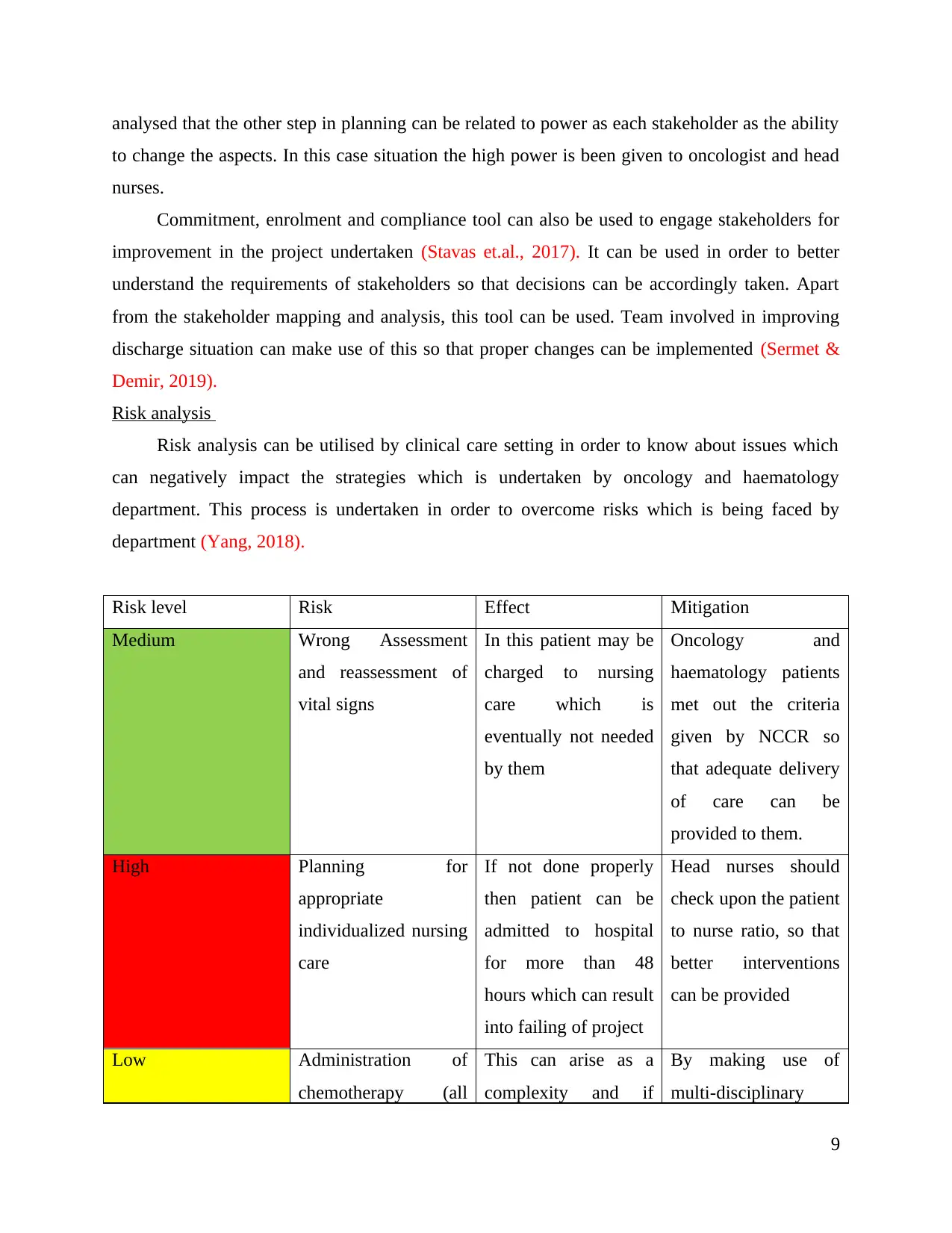
analysed that the other step in planning can be related to power as each stakeholder as the ability
to change the aspects. In this case situation the high power is been given to oncologist and head
nurses.
Commitment, enrolment and compliance tool can also be used to engage stakeholders for
improvement in the project undertaken (Stavas et.al., 2017). It can be used in order to better
understand the requirements of stakeholders so that decisions can be accordingly taken. Apart
from the stakeholder mapping and analysis, this tool can be used. Team involved in improving
discharge situation can make use of this so that proper changes can be implemented (Sermet &
Demir, 2019).
Risk analysis
Risk analysis can be utilised by clinical care setting in order to know about issues which
can negatively impact the strategies which is undertaken by oncology and haematology
department. This process is undertaken in order to overcome risks which is being faced by
department (Yang, 2018).
Risk level Risk Effect Mitigation
Medium Wrong Assessment
and reassessment of
vital signs
In this patient may be
charged to nursing
care which is
eventually not needed
by them
Oncology and
haematology patients
met out the criteria
given by NCCR so
that adequate delivery
of care can be
provided to them.
High Planning for
appropriate
individualized nursing
care
If not done properly
then patient can be
admitted to hospital
for more than 48
hours which can result
into failing of project
Head nurses should
check upon the patient
to nurse ratio, so that
better interventions
can be provided
Low Administration of
chemotherapy (all
This can arise as a
complexity and if
By making use of
multi-disciplinary
9
to change the aspects. In this case situation the high power is been given to oncologist and head
nurses.
Commitment, enrolment and compliance tool can also be used to engage stakeholders for
improvement in the project undertaken (Stavas et.al., 2017). It can be used in order to better
understand the requirements of stakeholders so that decisions can be accordingly taken. Apart
from the stakeholder mapping and analysis, this tool can be used. Team involved in improving
discharge situation can make use of this so that proper changes can be implemented (Sermet &
Demir, 2019).
Risk analysis
Risk analysis can be utilised by clinical care setting in order to know about issues which
can negatively impact the strategies which is undertaken by oncology and haematology
department. This process is undertaken in order to overcome risks which is being faced by
department (Yang, 2018).
Risk level Risk Effect Mitigation
Medium Wrong Assessment
and reassessment of
vital signs
In this patient may be
charged to nursing
care which is
eventually not needed
by them
Oncology and
haematology patients
met out the criteria
given by NCCR so
that adequate delivery
of care can be
provided to them.
High Planning for
appropriate
individualized nursing
care
If not done properly
then patient can be
admitted to hospital
for more than 48
hours which can result
into failing of project
Head nurses should
check upon the patient
to nurse ratio, so that
better interventions
can be provided
Low Administration of
chemotherapy (all
This can arise as a
complexity and if
By making use of
multi-disciplinary
9
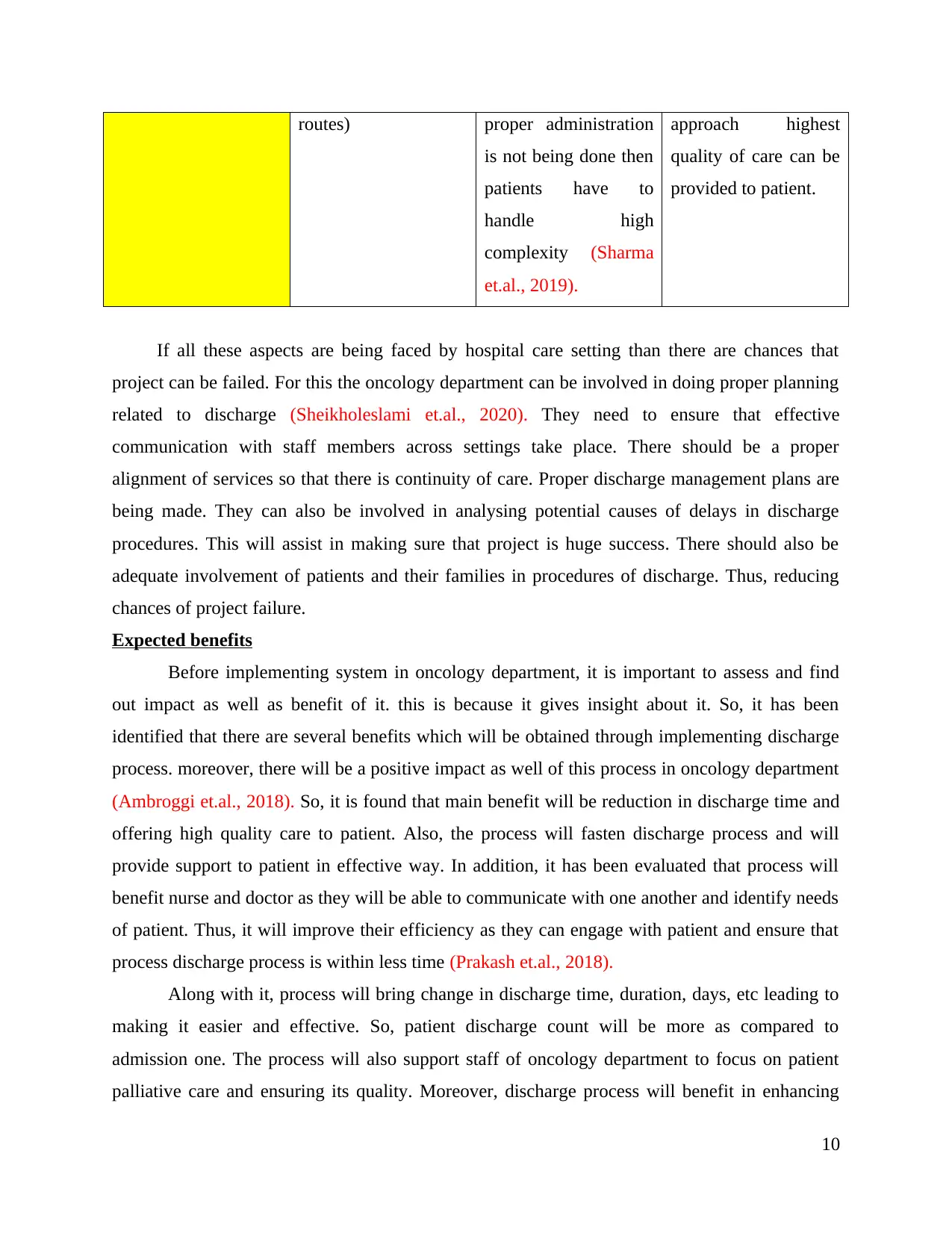
routes) proper administration
is not being done then
patients have to
handle high
complexity (Sharma
et.al., 2019).
approach highest
quality of care can be
provided to patient.
If all these aspects are being faced by hospital care setting than there are chances that
project can be failed. For this the oncology department can be involved in doing proper planning
related to discharge (Sheikholeslami et.al., 2020). They need to ensure that effective
communication with staff members across settings take place. There should be a proper
alignment of services so that there is continuity of care. Proper discharge management plans are
being made. They can also be involved in analysing potential causes of delays in discharge
procedures. This will assist in making sure that project is huge success. There should also be
adequate involvement of patients and their families in procedures of discharge. Thus, reducing
chances of project failure.
Expected benefits
Before implementing system in oncology department, it is important to assess and find
out impact as well as benefit of it. this is because it gives insight about it. So, it has been
identified that there are several benefits which will be obtained through implementing discharge
process. moreover, there will be a positive impact as well of this process in oncology department
(Ambroggi et.al., 2018). So, it is found that main benefit will be reduction in discharge time and
offering high quality care to patient. Also, the process will fasten discharge process and will
provide support to patient in effective way. In addition, it has been evaluated that process will
benefit nurse and doctor as they will be able to communicate with one another and identify needs
of patient. Thus, it will improve their efficiency as they can engage with patient and ensure that
process discharge process is within less time (Prakash et.al., 2018).
Along with it, process will bring change in discharge time, duration, days, etc leading to
making it easier and effective. So, patient discharge count will be more as compared to
admission one. The process will also support staff of oncology department to focus on patient
palliative care and ensuring its quality. Moreover, discharge process will benefit in enhancing
10
is not being done then
patients have to
handle high
complexity (Sharma
et.al., 2019).
approach highest
quality of care can be
provided to patient.
If all these aspects are being faced by hospital care setting than there are chances that
project can be failed. For this the oncology department can be involved in doing proper planning
related to discharge (Sheikholeslami et.al., 2020). They need to ensure that effective
communication with staff members across settings take place. There should be a proper
alignment of services so that there is continuity of care. Proper discharge management plans are
being made. They can also be involved in analysing potential causes of delays in discharge
procedures. This will assist in making sure that project is huge success. There should also be
adequate involvement of patients and their families in procedures of discharge. Thus, reducing
chances of project failure.
Expected benefits
Before implementing system in oncology department, it is important to assess and find
out impact as well as benefit of it. this is because it gives insight about it. So, it has been
identified that there are several benefits which will be obtained through implementing discharge
process. moreover, there will be a positive impact as well of this process in oncology department
(Ambroggi et.al., 2018). So, it is found that main benefit will be reduction in discharge time and
offering high quality care to patient. Also, the process will fasten discharge process and will
provide support to patient in effective way. In addition, it has been evaluated that process will
benefit nurse and doctor as they will be able to communicate with one another and identify needs
of patient. Thus, it will improve their efficiency as they can engage with patient and ensure that
process discharge process is within less time (Prakash et.al., 2018).
Along with it, process will bring change in discharge time, duration, days, etc leading to
making it easier and effective. So, patient discharge count will be more as compared to
admission one. The process will also support staff of oncology department to focus on patient
palliative care and ensuring its quality. Moreover, discharge process will benefit in enhancing
10
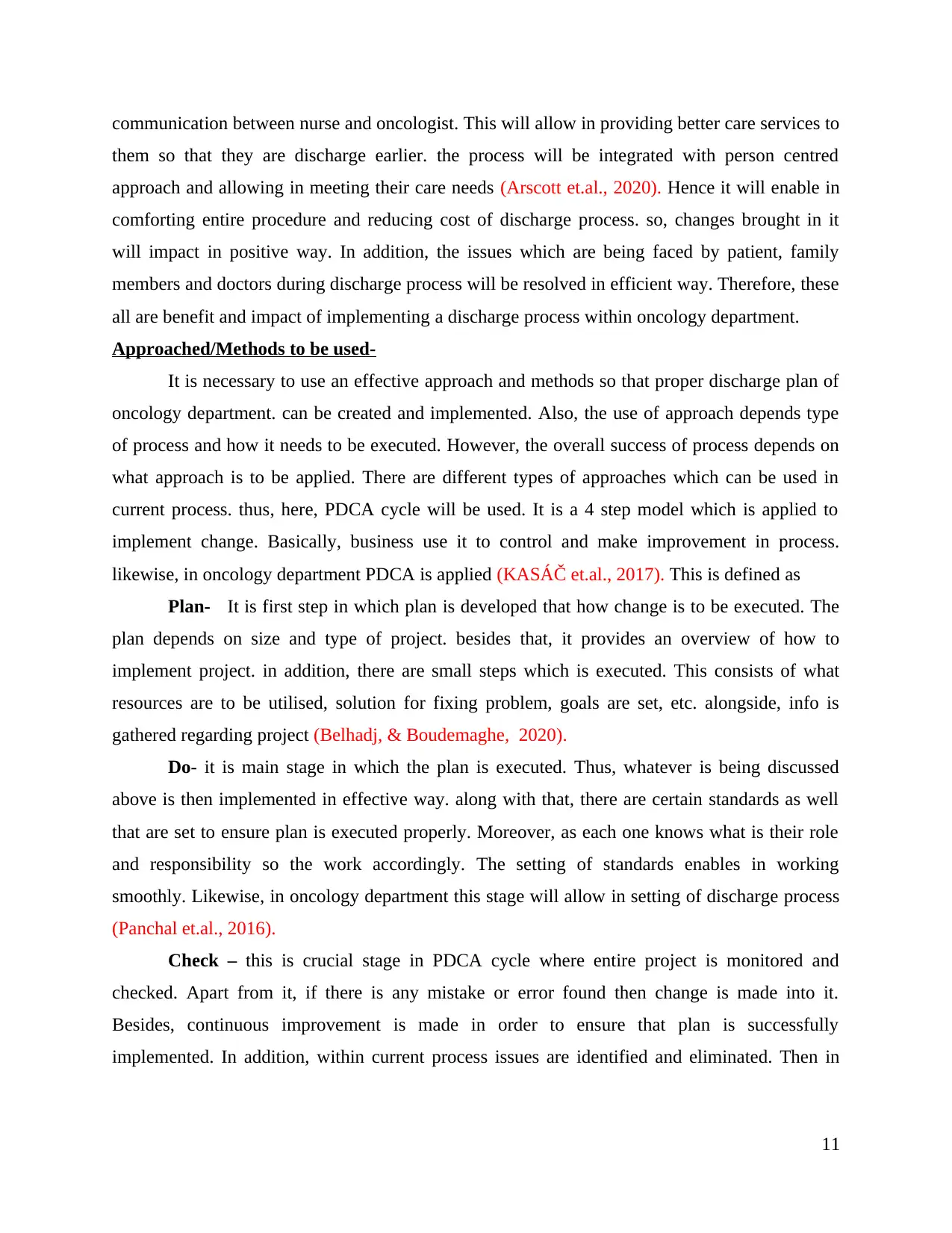
communication between nurse and oncologist. This will allow in providing better care services to
them so that they are discharge earlier. the process will be integrated with person centred
approach and allowing in meeting their care needs (Arscott et.al., 2020). Hence it will enable in
comforting entire procedure and reducing cost of discharge process. so, changes brought in it
will impact in positive way. In addition, the issues which are being faced by patient, family
members and doctors during discharge process will be resolved in efficient way. Therefore, these
all are benefit and impact of implementing a discharge process within oncology department.
Approached/Methods to be used-
It is necessary to use an effective approach and methods so that proper discharge plan of
oncology department. can be created and implemented. Also, the use of approach depends type
of process and how it needs to be executed. However, the overall success of process depends on
what approach is to be applied. There are different types of approaches which can be used in
current process. thus, here, PDCA cycle will be used. It is a 4 step model which is applied to
implement change. Basically, business use it to control and make improvement in process.
likewise, in oncology department PDCA is applied (KASÁČ et.al., 2017). This is defined as
Plan- It is first step in which plan is developed that how change is to be executed. The
plan depends on size and type of project. besides that, it provides an overview of how to
implement project. in addition, there are small steps which is executed. This consists of what
resources are to be utilised, solution for fixing problem, goals are set, etc. alongside, info is
gathered regarding project (Belhadj, & Boudemaghe, 2020).
Do- it is main stage in which the plan is executed. Thus, whatever is being discussed
above is then implemented in effective way. along with that, there are certain standards as well
that are set to ensure plan is executed properly. Moreover, as each one knows what is their role
and responsibility so the work accordingly. The setting of standards enables in working
smoothly. Likewise, in oncology department this stage will allow in setting of discharge process
(Panchal et.al., 2016).
Check – this is crucial stage in PDCA cycle where entire project is monitored and
checked. Apart from it, if there is any mistake or error found then change is made into it.
Besides, continuous improvement is made in order to ensure that plan is successfully
implemented. In addition, within current process issues are identified and eliminated. Then in
11
them so that they are discharge earlier. the process will be integrated with person centred
approach and allowing in meeting their care needs (Arscott et.al., 2020). Hence it will enable in
comforting entire procedure and reducing cost of discharge process. so, changes brought in it
will impact in positive way. In addition, the issues which are being faced by patient, family
members and doctors during discharge process will be resolved in efficient way. Therefore, these
all are benefit and impact of implementing a discharge process within oncology department.
Approached/Methods to be used-
It is necessary to use an effective approach and methods so that proper discharge plan of
oncology department. can be created and implemented. Also, the use of approach depends type
of process and how it needs to be executed. However, the overall success of process depends on
what approach is to be applied. There are different types of approaches which can be used in
current process. thus, here, PDCA cycle will be used. It is a 4 step model which is applied to
implement change. Basically, business use it to control and make improvement in process.
likewise, in oncology department PDCA is applied (KASÁČ et.al., 2017). This is defined as
Plan- It is first step in which plan is developed that how change is to be executed. The
plan depends on size and type of project. besides that, it provides an overview of how to
implement project. in addition, there are small steps which is executed. This consists of what
resources are to be utilised, solution for fixing problem, goals are set, etc. alongside, info is
gathered regarding project (Belhadj, & Boudemaghe, 2020).
Do- it is main stage in which the plan is executed. Thus, whatever is being discussed
above is then implemented in effective way. along with that, there are certain standards as well
that are set to ensure plan is executed properly. Moreover, as each one knows what is their role
and responsibility so the work accordingly. The setting of standards enables in working
smoothly. Likewise, in oncology department this stage will allow in setting of discharge process
(Panchal et.al., 2016).
Check – this is crucial stage in PDCA cycle where entire project is monitored and
checked. Apart from it, if there is any mistake or error found then change is made into it.
Besides, continuous improvement is made in order to ensure that plan is successfully
implemented. In addition, within current process issues are identified and eliminated. Then in
11
Paraphrase This Document
Need a fresh take? Get an instant paraphrase of this document with our AI Paraphraser
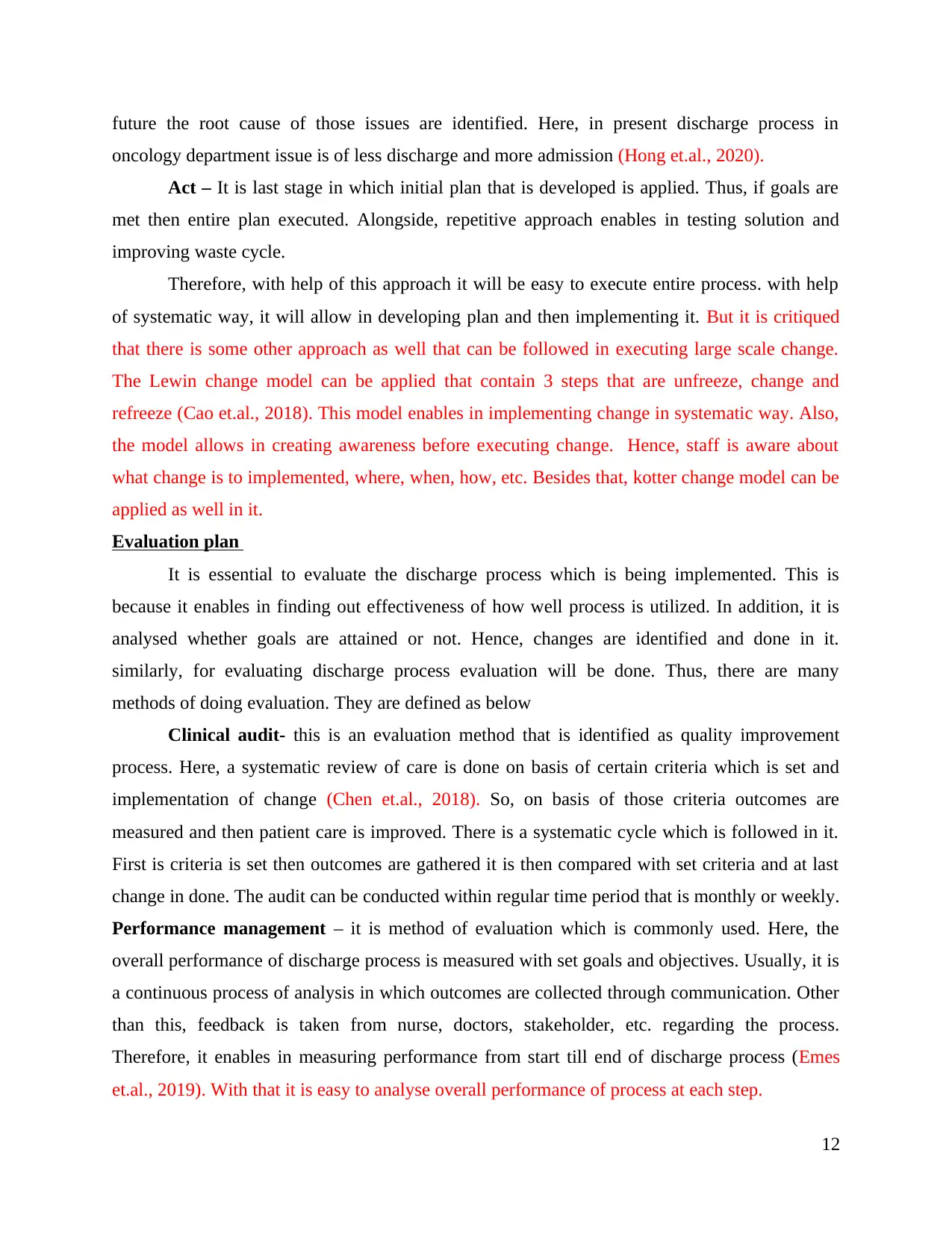
future the root cause of those issues are identified. Here, in present discharge process in
oncology department issue is of less discharge and more admission (Hong et.al., 2020).
Act – It is last stage in which initial plan that is developed is applied. Thus, if goals are
met then entire plan executed. Alongside, repetitive approach enables in testing solution and
improving waste cycle.
Therefore, with help of this approach it will be easy to execute entire process. with help
of systematic way, it will allow in developing plan and then implementing it. But it is critiqued
that there is some other approach as well that can be followed in executing large scale change.
The Lewin change model can be applied that contain 3 steps that are unfreeze, change and
refreeze (Cao et.al., 2018). This model enables in implementing change in systematic way. Also,
the model allows in creating awareness before executing change. Hence, staff is aware about
what change is to implemented, where, when, how, etc. Besides that, kotter change model can be
applied as well in it.
Evaluation plan
It is essential to evaluate the discharge process which is being implemented. This is
because it enables in finding out effectiveness of how well process is utilized. In addition, it is
analysed whether goals are attained or not. Hence, changes are identified and done in it.
similarly, for evaluating discharge process evaluation will be done. Thus, there are many
methods of doing evaluation. They are defined as below
Clinical audit- this is an evaluation method that is identified as quality improvement
process. Here, a systematic review of care is done on basis of certain criteria which is set and
implementation of change (Chen et.al., 2018). So, on basis of those criteria outcomes are
measured and then patient care is improved. There is a systematic cycle which is followed in it.
First is criteria is set then outcomes are gathered it is then compared with set criteria and at last
change in done. The audit can be conducted within regular time period that is monthly or weekly.
Performance management – it is method of evaluation which is commonly used. Here, the
overall performance of discharge process is measured with set goals and objectives. Usually, it is
a continuous process of analysis in which outcomes are collected through communication. Other
than this, feedback is taken from nurse, doctors, stakeholder, etc. regarding the process.
Therefore, it enables in measuring performance from start till end of discharge process (Emes
et.al., 2019). With that it is easy to analyse overall performance of process at each step.
12
oncology department issue is of less discharge and more admission (Hong et.al., 2020).
Act – It is last stage in which initial plan that is developed is applied. Thus, if goals are
met then entire plan executed. Alongside, repetitive approach enables in testing solution and
improving waste cycle.
Therefore, with help of this approach it will be easy to execute entire process. with help
of systematic way, it will allow in developing plan and then implementing it. But it is critiqued
that there is some other approach as well that can be followed in executing large scale change.
The Lewin change model can be applied that contain 3 steps that are unfreeze, change and
refreeze (Cao et.al., 2018). This model enables in implementing change in systematic way. Also,
the model allows in creating awareness before executing change. Hence, staff is aware about
what change is to implemented, where, when, how, etc. Besides that, kotter change model can be
applied as well in it.
Evaluation plan
It is essential to evaluate the discharge process which is being implemented. This is
because it enables in finding out effectiveness of how well process is utilized. In addition, it is
analysed whether goals are attained or not. Hence, changes are identified and done in it.
similarly, for evaluating discharge process evaluation will be done. Thus, there are many
methods of doing evaluation. They are defined as below
Clinical audit- this is an evaluation method that is identified as quality improvement
process. Here, a systematic review of care is done on basis of certain criteria which is set and
implementation of change (Chen et.al., 2018). So, on basis of those criteria outcomes are
measured and then patient care is improved. There is a systematic cycle which is followed in it.
First is criteria is set then outcomes are gathered it is then compared with set criteria and at last
change in done. The audit can be conducted within regular time period that is monthly or weekly.
Performance management – it is method of evaluation which is commonly used. Here, the
overall performance of discharge process is measured with set goals and objectives. Usually, it is
a continuous process of analysis in which outcomes are collected through communication. Other
than this, feedback is taken from nurse, doctors, stakeholder, etc. regarding the process.
Therefore, it enables in measuring performance from start till end of discharge process (Emes
et.al., 2019). With that it is easy to analyse overall performance of process at each step.
12
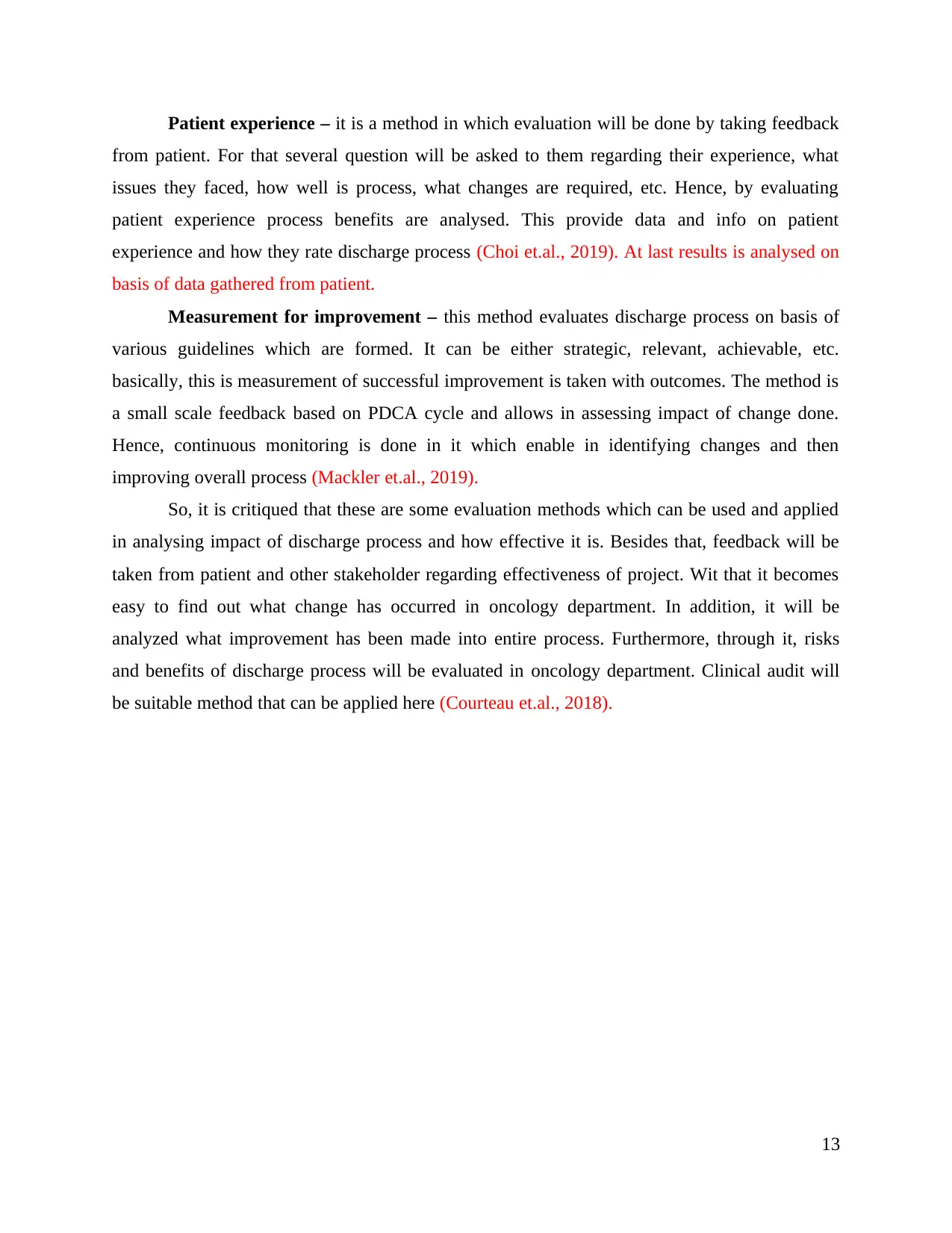
Patient experience – it is a method in which evaluation will be done by taking feedback
from patient. For that several question will be asked to them regarding their experience, what
issues they faced, how well is process, what changes are required, etc. Hence, by evaluating
patient experience process benefits are analysed. This provide data and info on patient
experience and how they rate discharge process (Choi et.al., 2019). At last results is analysed on
basis of data gathered from patient.
Measurement for improvement – this method evaluates discharge process on basis of
various guidelines which are formed. It can be either strategic, relevant, achievable, etc.
basically, this is measurement of successful improvement is taken with outcomes. The method is
a small scale feedback based on PDCA cycle and allows in assessing impact of change done.
Hence, continuous monitoring is done in it which enable in identifying changes and then
improving overall process (Mackler et.al., 2019).
So, it is critiqued that these are some evaluation methods which can be used and applied
in analysing impact of discharge process and how effective it is. Besides that, feedback will be
taken from patient and other stakeholder regarding effectiveness of project. Wit that it becomes
easy to find out what change has occurred in oncology department. In addition, it will be
analyzed what improvement has been made into entire process. Furthermore, through it, risks
and benefits of discharge process will be evaluated in oncology department. Clinical audit will
be suitable method that can be applied here (Courteau et.al., 2018).
13
from patient. For that several question will be asked to them regarding their experience, what
issues they faced, how well is process, what changes are required, etc. Hence, by evaluating
patient experience process benefits are analysed. This provide data and info on patient
experience and how they rate discharge process (Choi et.al., 2019). At last results is analysed on
basis of data gathered from patient.
Measurement for improvement – this method evaluates discharge process on basis of
various guidelines which are formed. It can be either strategic, relevant, achievable, etc.
basically, this is measurement of successful improvement is taken with outcomes. The method is
a small scale feedback based on PDCA cycle and allows in assessing impact of change done.
Hence, continuous monitoring is done in it which enable in identifying changes and then
improving overall process (Mackler et.al., 2019).
So, it is critiqued that these are some evaluation methods which can be used and applied
in analysing impact of discharge process and how effective it is. Besides that, feedback will be
taken from patient and other stakeholder regarding effectiveness of project. Wit that it becomes
easy to find out what change has occurred in oncology department. In addition, it will be
analyzed what improvement has been made into entire process. Furthermore, through it, risks
and benefits of discharge process will be evaluated in oncology department. Clinical audit will
be suitable method that can be applied here (Courteau et.al., 2018).
13
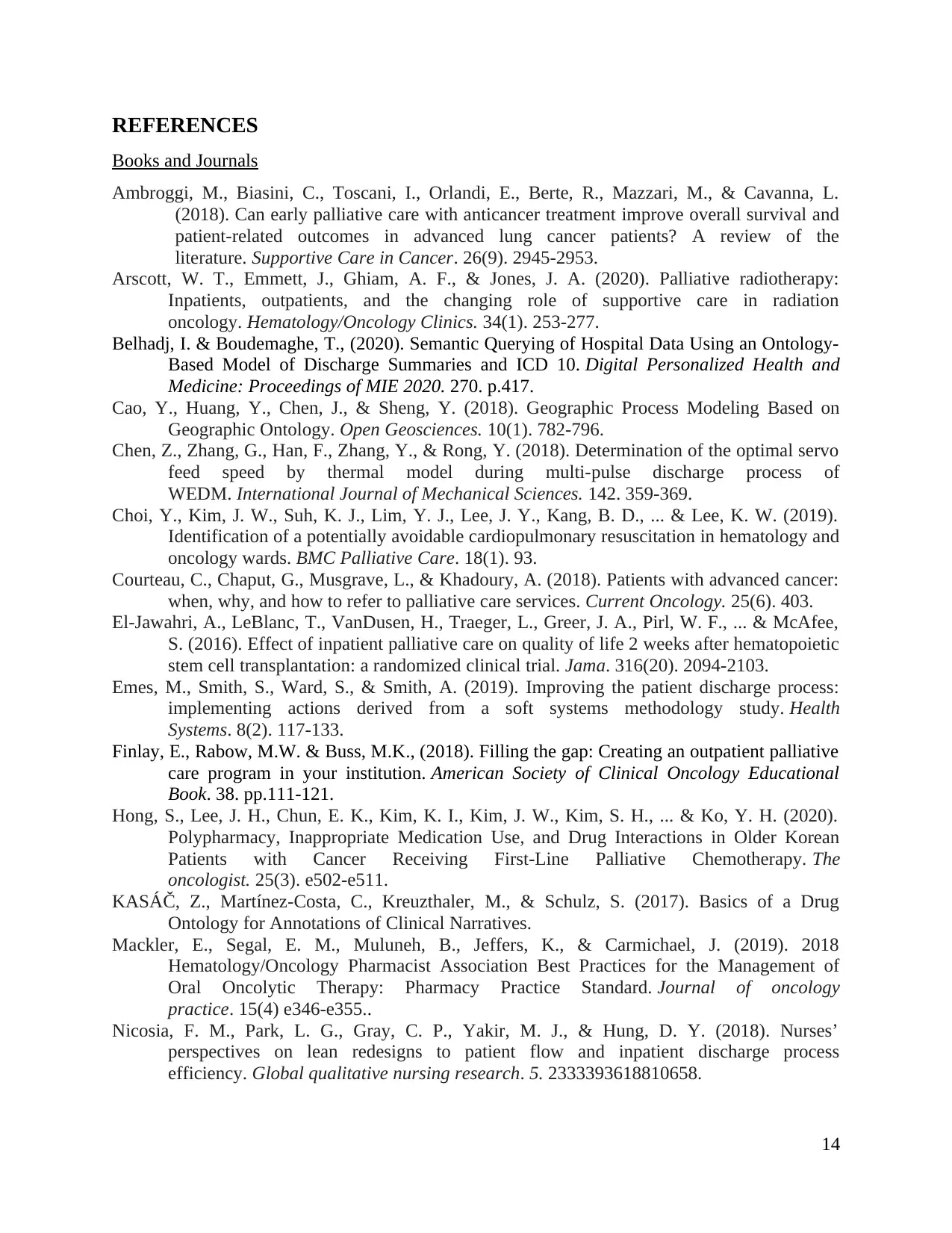
REFERENCES
Books and Journals
Ambroggi, M., Biasini, C., Toscani, I., Orlandi, E., Berte, R., Mazzari, M., & Cavanna, L.
(2018). Can early palliative care with anticancer treatment improve overall survival and
patient-related outcomes in advanced lung cancer patients? A review of the
literature. Supportive Care in Cancer. 26(9). 2945-2953.
Arscott, W. T., Emmett, J., Ghiam, A. F., & Jones, J. A. (2020). Palliative radiotherapy:
Inpatients, outpatients, and the changing role of supportive care in radiation
oncology. Hematology/Oncology Clinics. 34(1). 253-277.
Belhadj, I. & Boudemaghe, T., (2020). Semantic Querying of Hospital Data Using an Ontology-
Based Model of Discharge Summaries and ICD 10. Digital Personalized Health and
Medicine: Proceedings of MIE 2020. 270. p.417.
Cao, Y., Huang, Y., Chen, J., & Sheng, Y. (2018). Geographic Process Modeling Based on
Geographic Ontology. Open Geosciences. 10(1). 782-796.
Chen, Z., Zhang, G., Han, F., Zhang, Y., & Rong, Y. (2018). Determination of the optimal servo
feed speed by thermal model during multi-pulse discharge process of
WEDM. International Journal of Mechanical Sciences. 142. 359-369.
Choi, Y., Kim, J. W., Suh, K. J., Lim, Y. J., Lee, J. Y., Kang, B. D., ... & Lee, K. W. (2019).
Identification of a potentially avoidable cardiopulmonary resuscitation in hematology and
oncology wards. BMC Palliative Care. 18(1). 93.
Courteau, C., Chaput, G., Musgrave, L., & Khadoury, A. (2018). Patients with advanced cancer:
when, why, and how to refer to palliative care services. Current Oncology. 25(6). 403.
El-Jawahri, A., LeBlanc, T., VanDusen, H., Traeger, L., Greer, J. A., Pirl, W. F., ... & McAfee,
S. (2016). Effect of inpatient palliative care on quality of life 2 weeks after hematopoietic
stem cell transplantation: a randomized clinical trial. Jama. 316(20). 2094-2103.
Emes, M., Smith, S., Ward, S., & Smith, A. (2019). Improving the patient discharge process:
implementing actions derived from a soft systems methodology study. Health
Systems. 8(2). 117-133.
Finlay, E., Rabow, M.W. & Buss, M.K., (2018). Filling the gap: Creating an outpatient palliative
care program in your institution. American Society of Clinical Oncology Educational
Book. 38. pp.111-121.
Hong, S., Lee, J. H., Chun, E. K., Kim, K. I., Kim, J. W., Kim, S. H., ... & Ko, Y. H. (2020).
Polypharmacy, Inappropriate Medication Use, and Drug Interactions in Older Korean
Patients with Cancer Receiving First‐Line Palliative Chemotherapy. The
oncologist. 25(3). e502-e511.
KASÁČ, Z., Martínez-Costa, C., Kreuzthaler, M., & Schulz, S. (2017). Basics of a Drug
Ontology for Annotations of Clinical Narratives.
Mackler, E., Segal, E. M., Muluneh, B., Jeffers, K., & Carmichael, J. (2019). 2018
Hematology/Oncology Pharmacist Association Best Practices for the Management of
Oral Oncolytic Therapy: Pharmacy Practice Standard. Journal of oncology
practice. 15(4) e346-e355..
Nicosia, F. M., Park, L. G., Gray, C. P., Yakir, M. J., & Hung, D. Y. (2018). Nurses’
perspectives on lean redesigns to patient flow and inpatient discharge process
efficiency. Global qualitative nursing research. 5. 2333393618810658.
14
Books and Journals
Ambroggi, M., Biasini, C., Toscani, I., Orlandi, E., Berte, R., Mazzari, M., & Cavanna, L.
(2018). Can early palliative care with anticancer treatment improve overall survival and
patient-related outcomes in advanced lung cancer patients? A review of the
literature. Supportive Care in Cancer. 26(9). 2945-2953.
Arscott, W. T., Emmett, J., Ghiam, A. F., & Jones, J. A. (2020). Palliative radiotherapy:
Inpatients, outpatients, and the changing role of supportive care in radiation
oncology. Hematology/Oncology Clinics. 34(1). 253-277.
Belhadj, I. & Boudemaghe, T., (2020). Semantic Querying of Hospital Data Using an Ontology-
Based Model of Discharge Summaries and ICD 10. Digital Personalized Health and
Medicine: Proceedings of MIE 2020. 270. p.417.
Cao, Y., Huang, Y., Chen, J., & Sheng, Y. (2018). Geographic Process Modeling Based on
Geographic Ontology. Open Geosciences. 10(1). 782-796.
Chen, Z., Zhang, G., Han, F., Zhang, Y., & Rong, Y. (2018). Determination of the optimal servo
feed speed by thermal model during multi-pulse discharge process of
WEDM. International Journal of Mechanical Sciences. 142. 359-369.
Choi, Y., Kim, J. W., Suh, K. J., Lim, Y. J., Lee, J. Y., Kang, B. D., ... & Lee, K. W. (2019).
Identification of a potentially avoidable cardiopulmonary resuscitation in hematology and
oncology wards. BMC Palliative Care. 18(1). 93.
Courteau, C., Chaput, G., Musgrave, L., & Khadoury, A. (2018). Patients with advanced cancer:
when, why, and how to refer to palliative care services. Current Oncology. 25(6). 403.
El-Jawahri, A., LeBlanc, T., VanDusen, H., Traeger, L., Greer, J. A., Pirl, W. F., ... & McAfee,
S. (2016). Effect of inpatient palliative care on quality of life 2 weeks after hematopoietic
stem cell transplantation: a randomized clinical trial. Jama. 316(20). 2094-2103.
Emes, M., Smith, S., Ward, S., & Smith, A. (2019). Improving the patient discharge process:
implementing actions derived from a soft systems methodology study. Health
Systems. 8(2). 117-133.
Finlay, E., Rabow, M.W. & Buss, M.K., (2018). Filling the gap: Creating an outpatient palliative
care program in your institution. American Society of Clinical Oncology Educational
Book. 38. pp.111-121.
Hong, S., Lee, J. H., Chun, E. K., Kim, K. I., Kim, J. W., Kim, S. H., ... & Ko, Y. H. (2020).
Polypharmacy, Inappropriate Medication Use, and Drug Interactions in Older Korean
Patients with Cancer Receiving First‐Line Palliative Chemotherapy. The
oncologist. 25(3). e502-e511.
KASÁČ, Z., Martínez-Costa, C., Kreuzthaler, M., & Schulz, S. (2017). Basics of a Drug
Ontology for Annotations of Clinical Narratives.
Mackler, E., Segal, E. M., Muluneh, B., Jeffers, K., & Carmichael, J. (2019). 2018
Hematology/Oncology Pharmacist Association Best Practices for the Management of
Oral Oncolytic Therapy: Pharmacy Practice Standard. Journal of oncology
practice. 15(4) e346-e355..
Nicosia, F. M., Park, L. G., Gray, C. P., Yakir, M. J., & Hung, D. Y. (2018). Nurses’
perspectives on lean redesigns to patient flow and inpatient discharge process
efficiency. Global qualitative nursing research. 5. 2333393618810658.
14
Secure Best Marks with AI Grader
Need help grading? Try our AI Grader for instant feedback on your assignments.
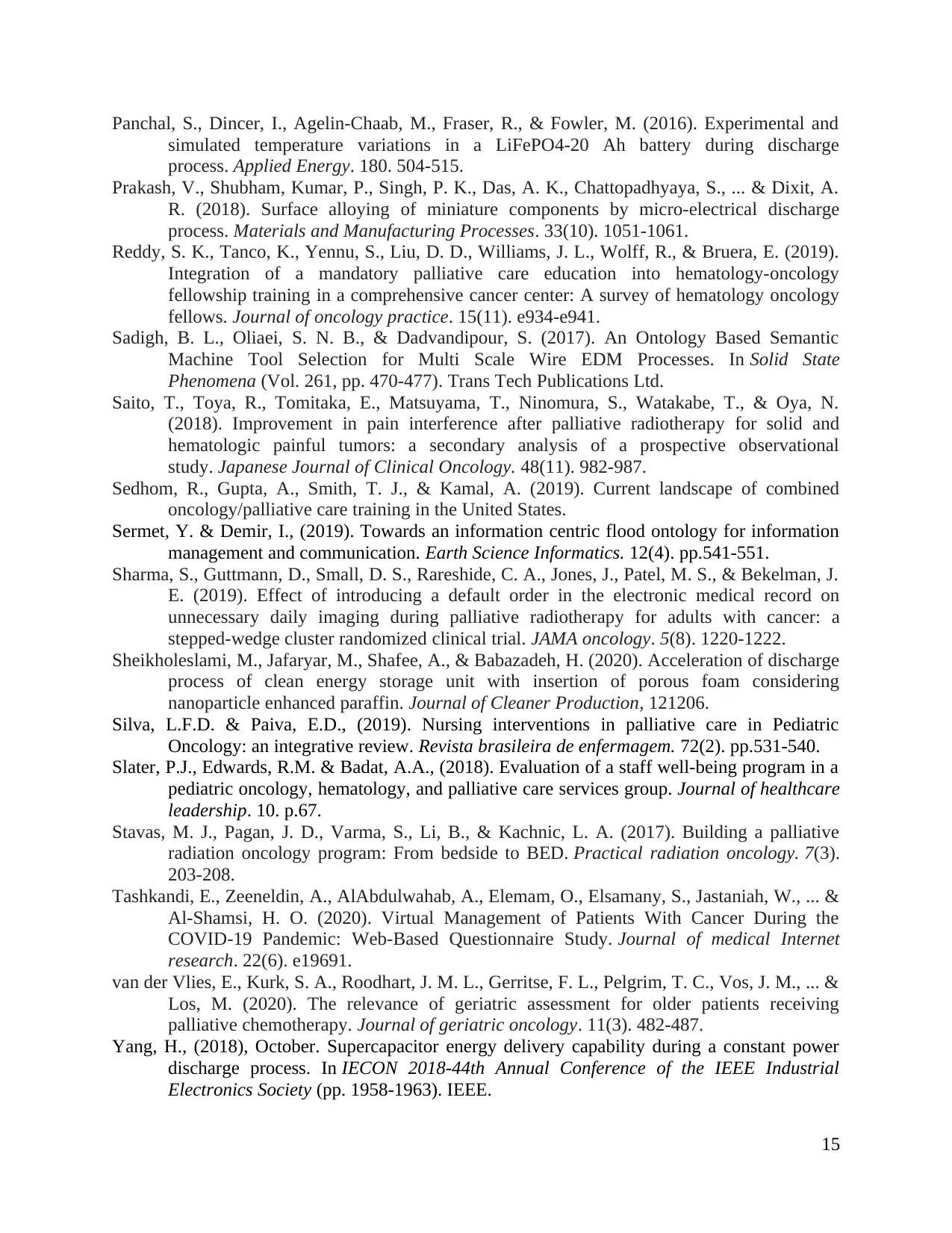
Panchal, S., Dincer, I., Agelin-Chaab, M., Fraser, R., & Fowler, M. (2016). Experimental and
simulated temperature variations in a LiFePO4-20 Ah battery during discharge
process. Applied Energy. 180. 504-515.
Prakash, V., Shubham, Kumar, P., Singh, P. K., Das, A. K., Chattopadhyaya, S., ... & Dixit, A.
R. (2018). Surface alloying of miniature components by micro-electrical discharge
process. Materials and Manufacturing Processes. 33(10). 1051-1061.
Reddy, S. K., Tanco, K., Yennu, S., Liu, D. D., Williams, J. L., Wolff, R., & Bruera, E. (2019).
Integration of a mandatory palliative care education into hematology-oncology
fellowship training in a comprehensive cancer center: A survey of hematology oncology
fellows. Journal of oncology practice. 15(11). e934-e941.
Sadigh, B. L., Oliaei, S. N. B., & Dadvandipour, S. (2017). An Ontology Based Semantic
Machine Tool Selection for Multi Scale Wire EDM Processes. In Solid State
Phenomena (Vol. 261, pp. 470-477). Trans Tech Publications Ltd.
Saito, T., Toya, R., Tomitaka, E., Matsuyama, T., Ninomura, S., Watakabe, T., & Oya, N.
(2018). Improvement in pain interference after palliative radiotherapy for solid and
hematologic painful tumors: a secondary analysis of a prospective observational
study. Japanese Journal of Clinical Oncology. 48(11). 982-987.
Sedhom, R., Gupta, A., Smith, T. J., & Kamal, A. (2019). Current landscape of combined
oncology/palliative care training in the United States.
Sermet, Y. & Demir, I., (2019). Towards an information centric flood ontology for information
management and communication. Earth Science Informatics. 12(4). pp.541-551.
Sharma, S., Guttmann, D., Small, D. S., Rareshide, C. A., Jones, J., Patel, M. S., & Bekelman, J.
E. (2019). Effect of introducing a default order in the electronic medical record on
unnecessary daily imaging during palliative radiotherapy for adults with cancer: a
stepped-wedge cluster randomized clinical trial. JAMA oncology. 5(8). 1220-1222.
Sheikholeslami, M., Jafaryar, M., Shafee, A., & Babazadeh, H. (2020). Acceleration of discharge
process of clean energy storage unit with insertion of porous foam considering
nanoparticle enhanced paraffin. Journal of Cleaner Production, 121206.
Silva, L.F.D. & Paiva, E.D., (2019). Nursing interventions in palliative care in Pediatric
Oncology: an integrative review. Revista brasileira de enfermagem. 72(2). pp.531-540.
Slater, P.J., Edwards, R.M. & Badat, A.A., (2018). Evaluation of a staff well-being program in a
pediatric oncology, hematology, and palliative care services group. Journal of healthcare
leadership. 10. p.67.
Stavas, M. J., Pagan, J. D., Varma, S., Li, B., & Kachnic, L. A. (2017). Building a palliative
radiation oncology program: From bedside to BED. Practical radiation oncology. 7(3).
203-208.
Tashkandi, E., Zeeneldin, A., AlAbdulwahab, A., Elemam, O., Elsamany, S., Jastaniah, W., ... &
Al-Shamsi, H. O. (2020). Virtual Management of Patients With Cancer During the
COVID-19 Pandemic: Web-Based Questionnaire Study. Journal of medical Internet
research. 22(6). e19691.
van der Vlies, E., Kurk, S. A., Roodhart, J. M. L., Gerritse, F. L., Pelgrim, T. C., Vos, J. M., ... &
Los, M. (2020). The relevance of geriatric assessment for older patients receiving
palliative chemotherapy. Journal of geriatric oncology. 11(3). 482-487.
Yang, H., (2018), October. Supercapacitor energy delivery capability during a constant power
discharge process. In IECON 2018-44th Annual Conference of the IEEE Industrial
Electronics Society (pp. 1958-1963). IEEE.
15
simulated temperature variations in a LiFePO4-20 Ah battery during discharge
process. Applied Energy. 180. 504-515.
Prakash, V., Shubham, Kumar, P., Singh, P. K., Das, A. K., Chattopadhyaya, S., ... & Dixit, A.
R. (2018). Surface alloying of miniature components by micro-electrical discharge
process. Materials and Manufacturing Processes. 33(10). 1051-1061.
Reddy, S. K., Tanco, K., Yennu, S., Liu, D. D., Williams, J. L., Wolff, R., & Bruera, E. (2019).
Integration of a mandatory palliative care education into hematology-oncology
fellowship training in a comprehensive cancer center: A survey of hematology oncology
fellows. Journal of oncology practice. 15(11). e934-e941.
Sadigh, B. L., Oliaei, S. N. B., & Dadvandipour, S. (2017). An Ontology Based Semantic
Machine Tool Selection for Multi Scale Wire EDM Processes. In Solid State
Phenomena (Vol. 261, pp. 470-477). Trans Tech Publications Ltd.
Saito, T., Toya, R., Tomitaka, E., Matsuyama, T., Ninomura, S., Watakabe, T., & Oya, N.
(2018). Improvement in pain interference after palliative radiotherapy for solid and
hematologic painful tumors: a secondary analysis of a prospective observational
study. Japanese Journal of Clinical Oncology. 48(11). 982-987.
Sedhom, R., Gupta, A., Smith, T. J., & Kamal, A. (2019). Current landscape of combined
oncology/palliative care training in the United States.
Sermet, Y. & Demir, I., (2019). Towards an information centric flood ontology for information
management and communication. Earth Science Informatics. 12(4). pp.541-551.
Sharma, S., Guttmann, D., Small, D. S., Rareshide, C. A., Jones, J., Patel, M. S., & Bekelman, J.
E. (2019). Effect of introducing a default order in the electronic medical record on
unnecessary daily imaging during palliative radiotherapy for adults with cancer: a
stepped-wedge cluster randomized clinical trial. JAMA oncology. 5(8). 1220-1222.
Sheikholeslami, M., Jafaryar, M., Shafee, A., & Babazadeh, H. (2020). Acceleration of discharge
process of clean energy storage unit with insertion of porous foam considering
nanoparticle enhanced paraffin. Journal of Cleaner Production, 121206.
Silva, L.F.D. & Paiva, E.D., (2019). Nursing interventions in palliative care in Pediatric
Oncology: an integrative review. Revista brasileira de enfermagem. 72(2). pp.531-540.
Slater, P.J., Edwards, R.M. & Badat, A.A., (2018). Evaluation of a staff well-being program in a
pediatric oncology, hematology, and palliative care services group. Journal of healthcare
leadership. 10. p.67.
Stavas, M. J., Pagan, J. D., Varma, S., Li, B., & Kachnic, L. A. (2017). Building a palliative
radiation oncology program: From bedside to BED. Practical radiation oncology. 7(3).
203-208.
Tashkandi, E., Zeeneldin, A., AlAbdulwahab, A., Elemam, O., Elsamany, S., Jastaniah, W., ... &
Al-Shamsi, H. O. (2020). Virtual Management of Patients With Cancer During the
COVID-19 Pandemic: Web-Based Questionnaire Study. Journal of medical Internet
research. 22(6). e19691.
van der Vlies, E., Kurk, S. A., Roodhart, J. M. L., Gerritse, F. L., Pelgrim, T. C., Vos, J. M., ... &
Los, M. (2020). The relevance of geriatric assessment for older patients receiving
palliative chemotherapy. Journal of geriatric oncology. 11(3). 482-487.
Yang, H., (2018), October. Supercapacitor energy delivery capability during a constant power
discharge process. In IECON 2018-44th Annual Conference of the IEEE Industrial
Electronics Society (pp. 1958-1963). IEEE.
15
1 out of 17
Related Documents
Your All-in-One AI-Powered Toolkit for Academic Success.
+13062052269
info@desklib.com
Available 24*7 on WhatsApp / Email
![[object Object]](/_next/static/media/star-bottom.7253800d.svg)
Unlock your academic potential
© 2024 | Zucol Services PVT LTD | All rights reserved.





